Il Vecchio
Author: Rüdiger Dorn
Publisher: Pegasus Spiele
Year: 2012
review by

| x |
|
|
|
|
|
|
|
|
|
|
|
|
|
|
|
|
|
|
|
|
|
|
|
|
|
|
|
|
|
|
|
|
|
|
|
|
|
|
|
|
|
|
|
|
|
|
|
|
|
|
|
|
|
|
|
|
|
|
|
|
|
|
|
|
|
 |
The power and influence of the Medici family in 15th century Florence is flourishing. The other important Florentine families are of course envious, and scheme to do something about it. In Il Vecchio, two to four noble families attempt to overthrow the Medici family and grasp control of the city. The family that managed to gain the most influence by the time the Medici family's power has subsided wins the game.
|
|
|
|
|
|
|
| x |
|
|
|
|
|
|
|
|
|
|
|
|
|
|
|
|
|
|
|
|
|
|
|
|
|
|
|
|
|
|
|
|
|
|
|
|
|
|
|
|
|
|
|
|
|
|
|
|
|
|
|
|
|
|
|
|
|
|
|
|
|
|
|
|
|
|
The board depicts a map of Tuscany. At five different locations there are influence tracks where the players can place their family members in order to score victory points at the end of the game. To place a family member you have to pay florins and tokens, all of which can be obtained from the five middlemen that roam the board.
|
|
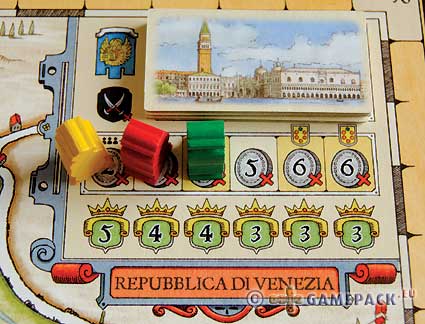 |
|
|
|
|
|
| x |
|
|
|
|
|
|
|
|
|
|
|
|
|
|
|
|
|
|
|
|
|
|
|
|
|
|
|
|
|
|
|
|
|
|
|
|
|
|
|
|
|
|
|
|
|
|
|
|
|
|
|
|
|
|
|
|
|
|
|
|
|
|
|
|
|
|
In a player's turn a player can move one of his family members at the expense of florins or a carriage token - available at your local purple middleman. When a player ends his movement in a city with a middleman, he may take the corresponding token or florins. If a player uses the services of the middleman, he was to put down his family member, who is thoroughly exhausted from the transaction: only at a later stage, family members can be revived again by spending an action. Additionally, the middleman travels on to the next city bearing a crest in the middleman's colour. This way, the middlemen travel around the board.
|
|
|
|
|
|
|
| x |
|
|
|
|
|
|
|
|
|
|
|
|
|
|
|
|
|
|
|
|
|
|
|
|
|
|
|
|
|
|
|
|
|
|
|
|
|
|
|
|
|
|
|
|
|
|
|
|
|
|
|
|
|
|
|
|
|
|
|
|
|
|
|
|
|
|

|
|
|
|
|
|
| x |
|
|
|
|
|
|
|
|
|
|
|
|
|
|
|
|
|
|
|
|
|
|
|
|
|
|
|
|
|
|
|
|
|
|
|
|
|
|
|
|
|
|
|
|
|
|
|
|
|
|
|
|
|
|
|
|
|
|
|
|
|
|
|
|
|
|
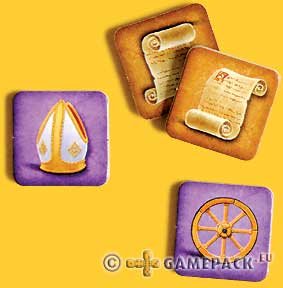
|
If a player is prepared to pay a bishop token, he doesn't put his family member down and the middleman doesn't travel on. The middleman doesn't even have to be present in this case: it suffices if the family member is in a city of the middleman's colour.
|
|
|
|
|
|
|
| x |
|
|
|
|
|
|
|
|
|
|
|
|
|
|
|
|
|
|
|
|
|
|
|
|
|
|
|
|
|
|
|
|
|
|
|
|
|
|
|
|
|
|
|
|
|
|
|
|
|
|
|
|
|
|
|
|
|
|
|
|
|
|
|
|
|
| When specific positions of the influence tracks are occupied, a Medici crest is removed from the board. When all crests are gone, the Medici family is deemed powerless and the game is over. All players count their victory points from the influence tracks and their collected tiles to determine a winner. |
|
|
|
|
|
|
| x |
|
|
|
|
|
|
|
|
|
|
|
|
|
|
|
|
|
|
|
|
|
|
|
|
|
|
|
|
|
|
|
|
|
|
|
|
|
|
|
|
|
|
|
|
|
|
|
|
|
|
|
|
|
|
|
|
|
|
|
|
|
|
|
|
|
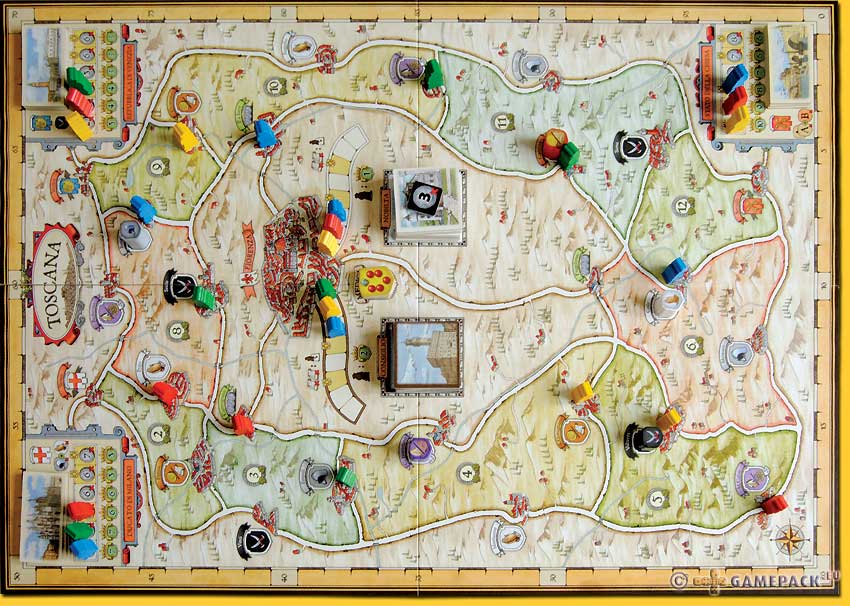 |
|
|
| x |
|
|
|
|
| x |
|
|
|
|
| x |
|
|
|
|
 |
|
|
|
|
|
|
|
|
|
|
|
|
|
|
|
|
|
|
|
|
|
|
|
|
|
|
|
|
|
|
|
|
|
|
|
|
|
|
|
|
|
|
|
|
|
|
|
|
|
|
|
|
|
|
|
|
|
The road to victory seems straightforward: place as many family members as possible on the influence tracks, preferably on the most valuable positions. Of course there are costs attached, so we all chase the middlemen around Tuscany to collect the required resources. After the transaction the middleman travels on: will he land in the open arms of an opponent? Because that is a present we'd rather not give away! Better use a bishop token: the middleman stays where he is, and the family member is not inactivated. As a result, the same middleman can be used by the same family member in the next turn, while the opponent is waiting in vain for the middleman to arrive. Luckily for him, there is always something interesting to do on the board. All players have multiple family members to choose from, at least one of them is bound to be close to where the action is! And if not, it is also possible to spend an action to place an new family member on the board.
|
|
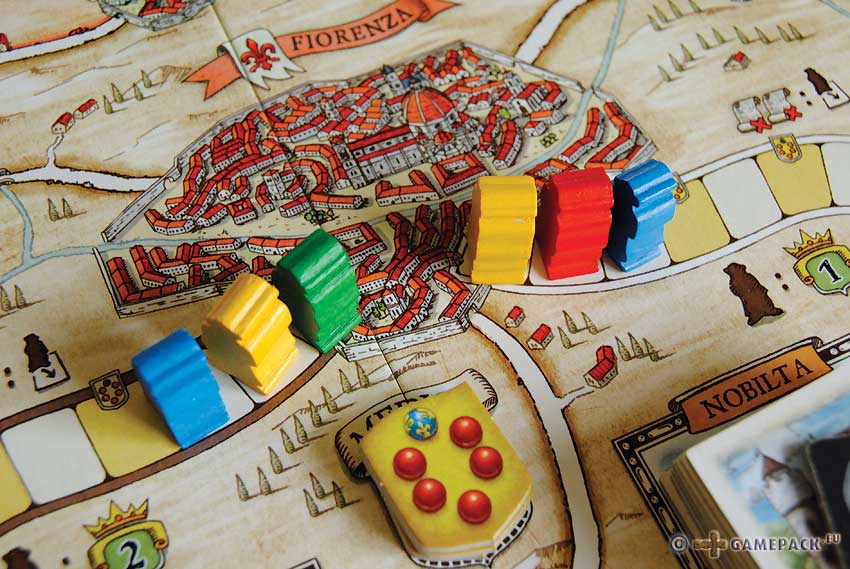 |
|
|
| x |
|
|
|
|
|
|
|
|
|
|
|
|
|
|
|
|
|
|
|
|
|
|
|
|
|
|
|
|
|
|
|
|
|
|
|
|
|
|
|
|
|
|
|
|
|
|
|
|
|
|
|
|
|
|
|
|
|
|
|
|
|
|
|
|
|
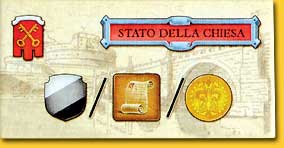 |
When a family member is placed on an influence track, the player may select a tile from the corresponding stack. Depending on the location the tiles are either for single use, or they give the player a permanent advantage, or they score points at the end of the game. These tiles can give a player a real boost, so it is worthwhile to place (many) family members on the cheaper tracks that yield less victory points but still earn you a tile, instead of saving a lot of resources to send only one favourite nephew to a very prestigious location. Because these tiles provide you with the means to earn a lot more points later on in the game!
|
|
|
|
|
|
|
| x |
|
|
|
|
|
|
|
|
|
|
|
|
|
|
|
|
|
|
|
|
|
|
|
|
|
|
|
|
|
|
|
|
|
|
|
|
|
|
|
|
|
|
|
|
|
|
|
|
|
|
|
|
|
|
|
|
|
|
|
|
|
|
|
|
|
|
Il Vecchio is a solid game; it offers enough strategic options to make it interesting, but it's not so rigid that some players, bothered by bad luck or annoying opponents, have to endure the entire game without a fair chance to victory. In combination with the transparent and simple rules and the clear and attractive design, this makes Il Vecchio a fine addition to the collection!
© 2013 Barbara van Vugt
|
|
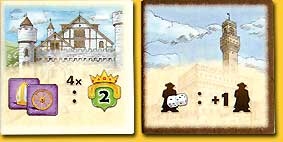 |
|
|
|
|
|
|
| x |
|
|
|
|
|
|
|
|
|
|
|
|
|
|
|
|
|
|
|
|
|
|
|
|
|
|
|
|
|
|
|
|
|
|
|
|
|
|
|
|
|
|
|
|
|
|
|
|
|
|
|
|
|
|
|
|
|
|
|
|
|
|
|
|
|
Il Vecchio, Rüdiger Dorn, Pegasus Spiele, 2012 - 2 to 4 players, 10 years and up, 60-80 minutes
|
|
|
|
|
  |
|
|
|
|
|
|
|
|
|
|
|
|
|
|
|
|
|
|
|
|
|
|
|
|
|
|
|
|
|
|
|
|
|
|
|
|
|
|
|
|
|
|
|
|
|
|
|
|
|
|
|
|
|
|
|
|
  |
Light to digest; the iconography is hard to interpret without the rules |
|
|
|
|
|
|
|
|
|
|
|
|
|
|
|
|
  |
Decent but a bit repetitive |
|
|
|
|
|
|
|
|
|
|
|
|
|
|
|
|
|
|
|
|
|
|
|
|
|
|
  |
|
|
|
|
|
|
|
|
|
|
|
|
|
|
|
|
|
|
|
|
|
|
|
|
|
|
|
|
|
|
|
|
|
|
|
|
|
|
|
|
|
|
|
|
|
|
|
|
|
|
|
|
|
|
|
|
| x |
|
|
|
|
|
|
|
|
|
|
|
|
|
|
|
|
|
|
|
|
|
|
|
|
|
|
|
|
|
|
|
|
|
|
|
|
|
|
|
|
|
|
|
|
|
|
|
|
|
|
|
|
|
|
|
|
|
|
|
|
|
|
|
|
|
| x |
|
|
|
|
|
|
|
|
|
|
|
|
|
|
|
|
|
|
|
|
|
|
|
|
|
|
|
|
|
|
|
|
|
|
|
|
|
|
|
|
|
|
|
|
|
|
|
|
|
|
|
|
|
|
|
|
|
|
|
|
|
|
|
|
|
 |
|
|
|
|
|
|
|
|
|
|
|
|
|
|
|
|
|
|
|
|
|
|
|
|
|
|
|
|
|
|
|
|
|
|
|
|
|
|
|
|
|
|
|
|
|
|
|
|
|
|
|
|
|
|
|
|
 |
|
|
|
|
|
|
|
|
|
|
|
|
|
|
|
|
|
|
|
|
|
|
|
|
|
|
|
|
|
|
|
|
|
|
|
|
|
|
|
|
|
|
|
|
|
|
|
|
|
|
|
|
|
|
|
|
| x |
|
|
|
|
|
|
|
|
|
|
|
|
|
|
|
|
|
|
|
|
|
|
|
|
|
|
|
|
|
|
|
|
|
|
|
|
|
|
|
|
|
|
|
|
|
|
|
|
|
|
|
|
|
|
|
|
|
|
|
|
|
|
|
|
|
 |
|
|
|
|
|
|
|
|
|
|
|
|
|
|
|
|
|
|
|
|
|
|
|
|
|
|
|
|
|
|
|
|
|
|
|
|
|
|
|
|
|
|
|
|
|
|
 |
|
|
|
|
|
|
|
|
|
|
|
|
|
|
|
|
|
|
|
|
|
|
|
|
|
|
|
|
|
|
|
|
|
|
|
|
|
|
|
|
|
|
|
|
|
|